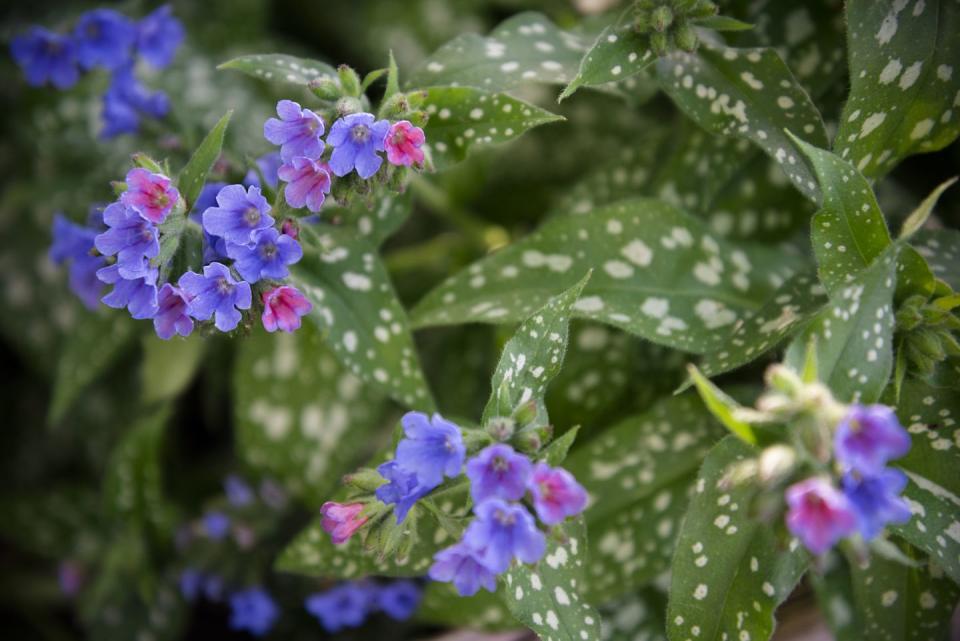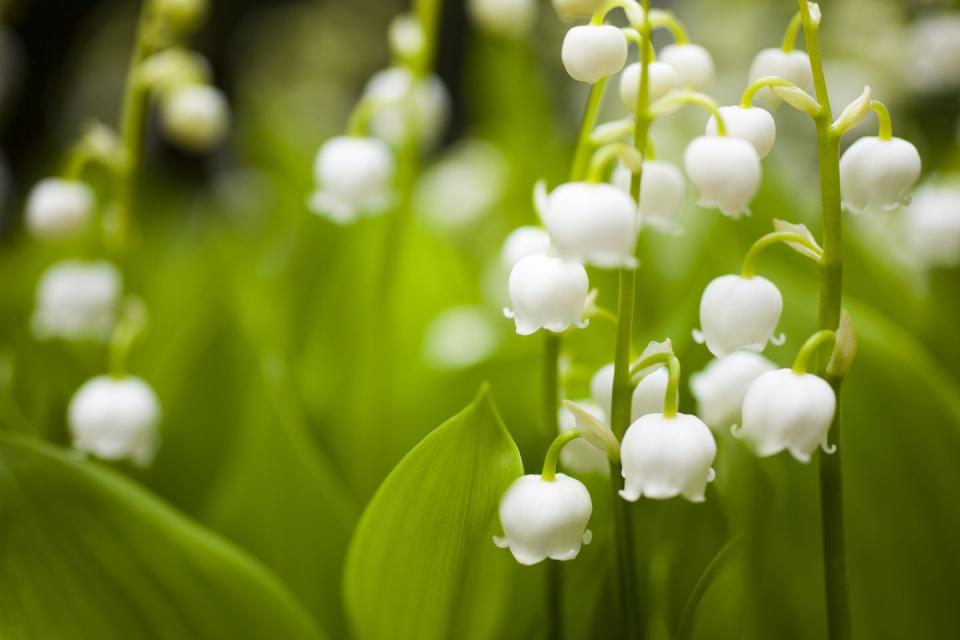Plant Shade-Loving Perennials Now, So They Can Flourish In the Spring!
"Hearst Magazines and Yahoo may earn commission or revenue on some items through these links."
Got shade? Sun-loving plants are big and flashy, but that doesn't mean the shady spots in your garden and backyard can't look great, too.
Many long-lived perennials love the shade! From flowers to ferns, shade perennials can be just as stunning as sun lovers.
When Is Best to Plant Perennials?
The fall is actually a great time to plant perennials! Since you'll want them to be there for years, putting them in the ground now, while the plants are not busy growing, gives their roots time to get established in the soil. Then, as soon as the spring comes, they can put their energy into producing leaves and petals!
What Plants Grow Well In Shade?
Many different types of plants grow well in shade, including flowering plants and those grown mainly for their colorful foliage. The most important thing to remember is to choose the right plant for the right place. Shade lovers will not do well in full sun, for instance. Don't try to cheat. Nature doesn't work that way!
Also, make sure a perennial you fall in love with can survive winters in your USDA hardiness zone. (Find your zone here.) Be aware that the hardiness zones were recently updated.
How Many Hours of Sun Is Considered Part Shade?
There are several terms you're likely to find on plant tags: Full sun, part sun, part shade, and full shade. Full shade means a spot never gets direct sunlight, or only very short amount of mild, morning sunshine. Part shade means about 4 hours of sun—but mostly morning sun, not blazing-hot afternoon sun.
Part sun mean 4 to 6 hours of sun per day, including some afternoon sun. And full sun means 6 or more hours of sunlight.
So: before selecting plants for an area, pay attention to how much shade it receives. Watch the area for a few days, checking the spot at different times of day to figure out when it's getting direct sunlight, and when it's not. Then choose the plants you want to place there accordingly.
Finally, make sure to give your plant a good start in life by watering well for the first season (or two) after planting so that it can establish sturdy roots. Strong roots mean a strong plant that will thrives for years with little help from you!
More great gardening ideas:
Bergenia
Also known by the irresistible name of pigsqueak, this part-shade perennial blooms in early spring. Trim it up as a handsome foliage plant after the blooms fade.
Varieties to try: Miss Piggy, Peppermint Patty
Related: The Best Spring Bulbs for Your Garden

Ligularia
Sometimes called "leopard plant," Ligularia is an excellent choice for any shade garden—and not just because deer don't enjoy eating it.
"One of the other nice things about this plant is its striking, purplish-red leaves," adds Daryl Beyers, author of The New Gardener's Handbook. "There's another variety that features yellow, daisy-looking flowers, and yet another called 'The Rocket' that boasts spikier blooms."
Varieties to try: Desdemona, Britt-Marie Crawford, The Rocket
Related: 26 Best Shade Annuals for Bare Spots In Your Garden

Hosta
Hosta is a go-to plant for shady areas. Primarily a foliage plant, the broad-leafed beauty can actually be very small or very large.
"Sum and Substance is a variety that gets huge—about five feet across," says Beyers. "Meanwhile, Mouse Ears is really, really tiny." But heads up: Avoid this plant if deer browse your yard frequently.
Varieties to try: Sum and Substance, Mouse Ears, Shadowland Empress Wu, Shadowland Autumn Frost
Learn More: How to Care for Hostas

Spiderwort
Spiderwort or tradescantia is a part shade—not deep shade—plant. It features an intricate flower and can grow anywhere from a foot-and-a-half to two feet tall.
"The variety Sweet Kate has unique, chartreuse-colored leaves," says Beyers.
Varieties to try: Sweet Kate, Concord Grape, Webmaster
Related: The 20 Best Patio Plants for a Lush Outdoor Space

Woodland Stonecrop
While some sedums can tolerate a bit of shade, one that thrives in it is Sedum ternatum, or woodland stonecrop.
Native to the U.S., this low-growing plant does well in moist, rocky soil and produces tiny white flowers. One editor grows it in a shady terrace bed along with a dwarf Japanese maple and hostas.
Learn More: How to Grow Autumn Joy Sedum

Viola
These spring bloomers tolerate some sun, but they prefer part to full shade, especially in the heat of summer. Some types are fragrant, too. If you like to cook, they're also edible!
Varieties to try: Penny Purple Picotee, Johnny Jump-Up
Related: 25 Fragrant Plants You Need In Your Garden

Astilbe
Lacey, toothed leaves and feathery plumes of pink, white, red, or purple flowers bloom in profusion in early to midsummer. A little morning sun helps them bloom better.
Varieties to try: Dark Side of the Moon, Milk and Honey
Related: 38 Deer-Resistant Plants Bambi Won't Go Near

Lamium
Lamium has silvery, variegated foliage and yellow, pink, white or or purple blooms. It's super-easy to grow and needs almost no care once established.
Varieties to try: Pink Chablis, Purple Chablis
Related: 30 Best Pink Flowers for An Enchanting Garden

Heuchera
Grown primarily for its colorful ruffled foliage, this perennial's mounding habit shoots up small flower spikes in spring to mid-summer, which hummingbirds love!
Some varieties tolerate full sun, but many prefer shade.
Varieties to try: Dolce Appletini, Primo Pistachio
Related: 21 Flowers That Hummingbirds Adore

Epimedium
These little plants are also known as fairy wings or bishop’s cap due to the adorable shape of their flowers, which appear in early spring.
They don’t like foot traffic, so plant them where they won’t be stepped on. They are one of the few ground cover plants that does fairly well in dry shade.
Varieties to try: Pink Champagne, Lilafee

Ferns
Frothy-looking ferns are sturdier than they appear, popping up again after even the toughest winters. They prefer moist ground but are fairly drought-tolerant once established.
Varieties to try: Autumn, Japanese Painted

Hellebore
These cold-tolerant plants produce unusual, long-lasting blooms in late winter or very early spring. Also known as Lenten rose because they bloom around the time of Lent, the foliage is evergreen.
Varieties to try: Wedding Party Confetti Cake, Wedding Party Childhood Sweetheart, Honeymoon Irish Luck

Foamflower
Lobed foliage with red or purple veins make this plant unique. Also known as tiarella, this plant boasts floaty little flowers that resemble foam on long stems in late spring to early summer.
Varieties to try: Cutting Edge, Jade Peacock

Toad Lily
The intricate flowers (spotted like a toad!) are the reason to grow these little gems. They bloom mid-to-late summer to fall in a variety of spotted colors ranging from white to lavender.
Varieties to try: Purple Beauty, Raspberry Mousse

Bletilla
This exotic-looking flower, also known as ground orchid, appears in early spring in white, purple, and various shades of pink. Its blooms often last up to six weeks.
It’s an unusual landscape plant for warmer climates, or it can be overwintered indoors in containers.
Varieties to try: White Pearl, Kate

Siberian Bugloss
This perennial with a funny name is grown for its striking foliage and graceful sprays of long-lasting, tiny blue flowers, which appear in spring. Also known as brunnera, it’s a hardy, low-maintenance plant.
Varieties to try: Jack Frost, Queen of Hearts

Corydalis
Tubular lightly-scented spring flowers hang above finely-cut foliage. The plant is ideal for warm climates. Foliage may die back in summer and sprout again in fall.
Varieties to try: Purple Bird, Canary Feathers

Bleeding Heart
It's easy to see how this old-fashioned favorite gets its name. Perhaps unsurprisingly, they're often ascribes special meaning on Valentine's Day.
Sprays of late spring to early summer flowers come in a variety of colors ranging from deep red to pink with lime-green to dark green foliage.
Varieties to try: White Diamonds, Pink Diamonds

Lungwort
This pretty ground cover blooms in early to late spring with small bell-shaped flowers and spotted foliage.
It looks best planted en masse. The un-glamorous name comes from its historic usage to treat lung ailments!
Varieties to try: Spot On, Pink-a-Blue
Related: 25 Best Ground Covers for Backyard Bald Spots

Foxglove
Although this perennial blooms well in full sun, it tolerates part shade, especially in hot climates. The tall spiked flowers are a standard in cottage gardens and cutting gardens.
Varieties to try: Polkadot Princess, Foxy
Related: Here's How to Grow An At-Home Cutting Garden

Trillium
The triangular shape and three leaves below the blooms of this striking native flower gives the plant its name. It's hardy, showy, and tolerates wet soil.
Varieties to try: White, Red

Jack-in-the-Pulpit
This intriguing native perennial blooms in late spring. The flower spike is the “jack” while the hood is the “pulpit.”
Varieties to try: Crossing Over, Triphyllum

Lily of the Valley
These delicate bells dangle on short stems and have a strong fragrance. It's a ground cover that spreads readily, so be careful where you plant it--choose an area, such as in between the house and sidewalk, where it can't get too aggressive.
Varieties to try: Bordeaux, Rose
Learn More: The Special Symbolism Behind Lily of the Valley

Caladium
Huge heart-shaped leaves in splashy colors offer plenty of drama. They’re tropical so if you live in a cool climate, put them in pots so they can be brought indoors and enjoyed as a houseplant over the winter.
Varieties to try: Bold 'N Beautiful, Blushing Bride
Read more: 55 Favorite Container Plants and Ideas for Your Potted Garden

Solomon’s Seal
This native perennial boasts a thick blanket of deep-green leaves that grow on upright red stems. Pendulous tuber-shaped flowers dangle from the stems in late spring and become bluish berries in the fall.
Varieties to try: Ruby Slippers, Fireworks

What Is The Longest-Blooming Shade Perennial?
Some of the longest-blooming shade perennials include lungwort, heuchera, hellebore, foxglove, corydalis, and lamium. These plants flower for several weeks at a time.
However, remember that perennials typically have a much shorter bloom period overall than annuals. While many annuals can bloom from spring planting to frost, most perennials bloom for a comparatively short period of time of several weeks.
To offset this, try planting a succession of perennials with blooms ranging from early spring to later summer. That will help you to have season-long color.
If you need longer-lasting color, mix in some shade-loving annuals alongside your shade perennials.

Do Any Flowers Grow in Full Shade?
Many flowers and plants that grow in full shade still do better with a little morning sun, to be honest.
However, if you have a very shady spot in your garden that barely ever sees the sun, consider super-hardy perennials such as ferns, lily of the valley, hostas (although they need a little morning sun for their best colors to emerge), caladiums, and epimediums.
While many of these plants are known more for their foliage than their flowers, they'll still create plenty of eye-catching beauty in your garden!

You Might Also Like

 Yahoo Lifestyle
Yahoo Lifestyle 
